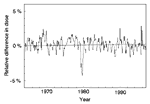
|

|

|
||||||||||||||||||||||||||||||||
|
WARNING: this web page is no longer maintained. The information it contains may be incorrect or out of date. Recent values of the three principal modulation parameters The three potentials considered here are:
References : O'Brien K.: 1971, Nuovo Cimento, A3, 52-78O Nymmik R.A., Panasyuk M.I. et Suslov A.A.: 1996, Adv. Space Research, 17, (2)19 (2)30. Badhwar G.D.and O'Neill P.M.: 1996, Adv. Space Research, 17, (2)7-(2)17. On the calculation of the heliocentric potential given here The monthly values of the heliocentric potential are calculated using the observed monthly averages of the cosmic ray intensity measured with the French neutron monitor located at Port-aux-Français, in the Kerguelen Islands (South Indian Ocean). The original heliocentric potential is given by the US FAA site. The heliocentric potential data given by this site for the period 1964 to 1997 have been fitted with the Kerguelen neutron monitor output using a 2nd degree polynom. This function is then used to calculate the heliocentric potential given here, deduced from the Kerguelen observations. The same is done with the Dumont d'Urville neutron monitor (in Terre Adélie, Antarctic) as a back-up.  The following figure shows the monthly relative difference (in %)
between the dose calculated with CARI-6 model, for a flight from Paris
to San Francisco, with the original heliocentric potential on the one
hand and with the potential deduced from Kerguelen
observations on the other hand. The difference is only of a few
percents. The period shown is the period from 1964 to 1997, used to
fit the data. After 1997 the difference is larger, possibly due to
changes of monitors, but it remains smaller than 6 % pic to pic, which
is still a good precision for a biological dose. The following figure shows the monthly relative difference (in %)
between the dose calculated with CARI-6 model, for a flight from Paris
to San Francisco, with the original heliocentric potential on the one
hand and with the potential deduced from Kerguelen
observations on the other hand. The difference is only of a few
percents. The period shown is the period from 1964 to 1997, used to
fit the data. After 1997 the difference is larger, possibly due to
changes of monitors, but it remains smaller than 6 % pic to pic, which
is still a good precision for a biological dose. | ||||||||||||||||||||||||||||||||||